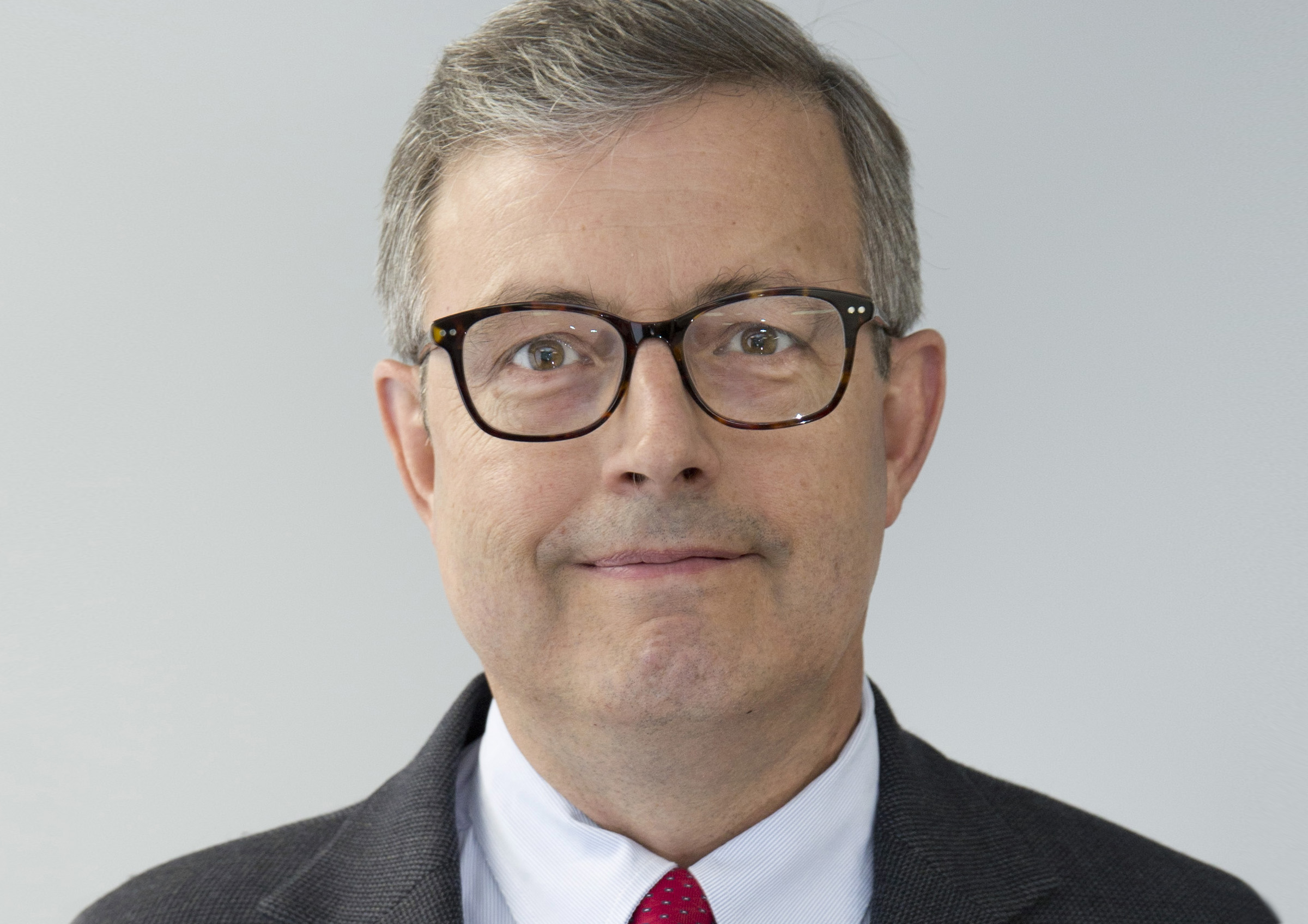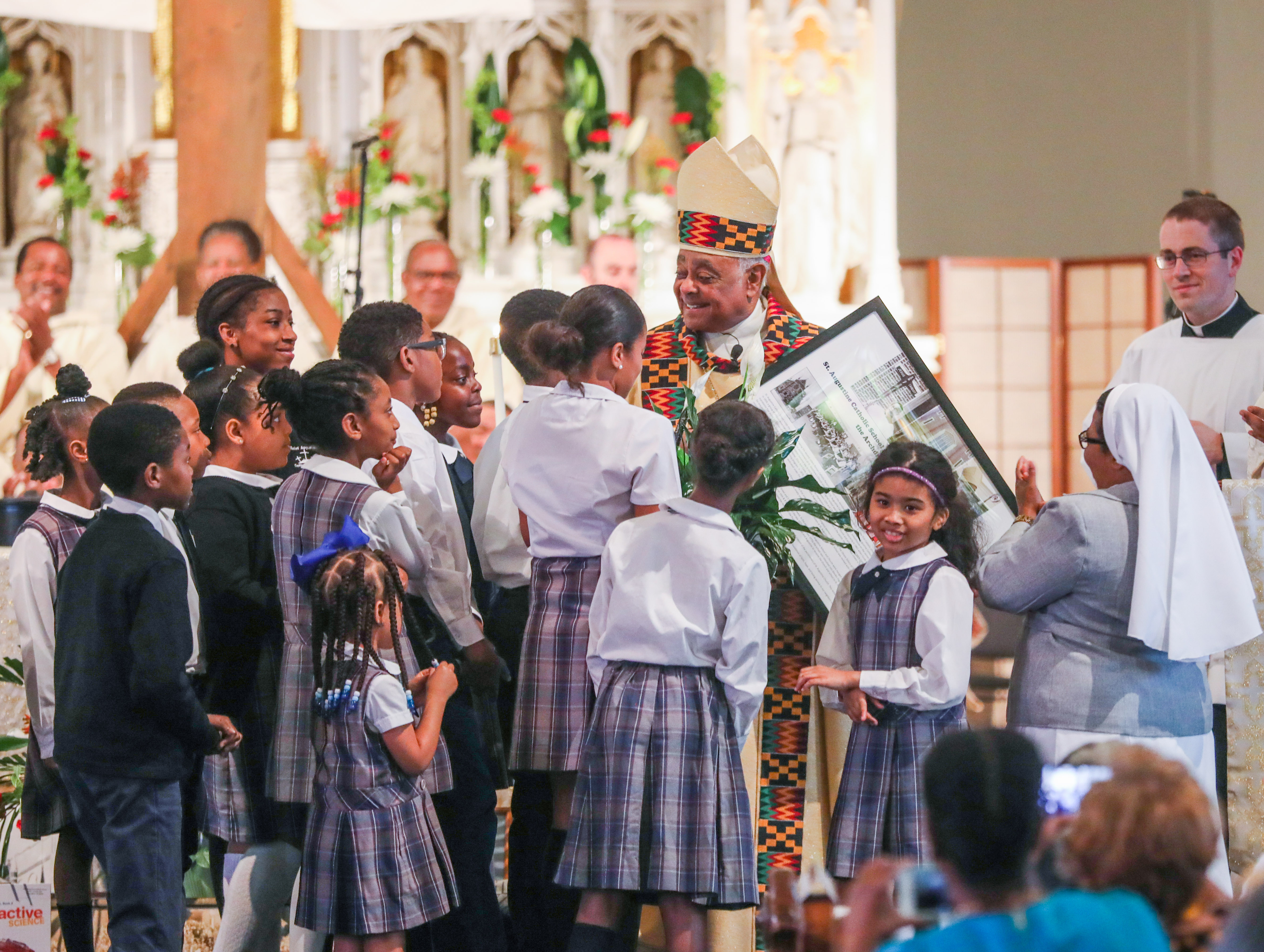As they have ever since free men and women of color – including some people emancipated from slavery – founded their parish in 1858, members of St. Augustine Parish gathered inside their church to praise God at Mass on June 2.
But on that day, the mother church of Black Catholics in the nation’s capital literally opened its doors to history, as it often has in its past. And when new Washington Archbishop Wilton Gregory appeared in the doorway of St. Augustine Church to celebrate the Mass, people offered a spontaneous standing ovation and shouts of joy.
The nearly 50 voices in the combined St. Augustine Gospel Choir and Chorale sang a soaring opening hymn, “Let Heavenly Music Fill This Place,” and Archbishop Gregory smiled broadly as he held his crosier and blessed the congregation while he processed to the altar. As he walked by, many people in the congregation took photos of him with their cell phones.
Moments later, Father Patrick Smith, St. Augustine’s pastor, said, “It is with great pleasure and gratitude to God that we welcome you to the parish of St. Augustine,” and the congregation again offered loud applause. He noted how the parish on that day had “the privilege and honor to welcome you as the first African American archbishop of Washington.”
Archbishop Gregory, who appeared profoundly moved by the parish’s welcome and by the opening hymn, offered a gesture of thanks. Father Smith noted that the archbishop’s presence was “uniquely historic and profoundly affirming” to the parish, and he pointed out how St. Augustine’s founders started their parish to provide a Catholic school for black children, and 100 years later, in 1958, St. Carthage School in Chicago opened its doors to black students in its neighborhood, “and one of those was a boy named Wilton,” who found his faith and vocation there, and who now joined them at Mass as the archbishop of Washington.
Father Smith, whose parish school continues its educational legacy in serving minority children in its neighborhood, said “we in the archdiocese and in this parish owe a debt of gratitude to the priests and sisters who opened their hearts” to educating black children in that Chicago parish, and “because of that, we are able to say, ‘Archbishop Wilton Gregory, welcome to Washington.’”

Later in his homily, Archbishop Gregory acknowledged St. Augustine’s history and “how it is identified with the sacred heritage of African American Catholics.”
“I stand on holy ground, as do all of you when you gather each Sunday for the Eucharist,” he said. “…Today a son of the African diaspora stands in your midst as the shepherd of the entire family of faith that is the Archdiocese of Washington.”
Preaching about that day’s solemnity, Archbishop Gregory said, “The Ascension of the Lord Jesus today calls us all to long for that day when we will be joined with Christ and His Father through the grace of the Holy Spirit.”
He noted that artists over the centuries have depicted heaven as a place of billowy clouds with winged angels, or as a great banquet hall, while many adults and children think of it as a place where their earthly desires will be fulfilled. He noted that churches are designed to “connect us to the past, and they must also point us to the future we long for with Jesus.”

Heaven, he said, “is that place where we will be known and loved… by One worthy of all love… (and) be united with our Lord, who fashioned us to be united with Him forever.”
Archbishop Gregory said heaven is a place where people will come face-to-face “with the Father who created us, with the Son who redeemed us, and with the Holy Spirit who guides us.” The archbishop also said that in heaven, people also will be united with people of faith who have come before and will come after them.
“Heaven won’t be complete until we are all there together,” the archbishop said as he was completing his homily, and the congregation gave him a standing ovation afterward.
In the offertory procession, two students from St. Augustine Catholic School, a girl and a boy wearing their uniforms, handed the bread and wine to Archbishop Gregory. They were preceded by adults carrying special mementos of St. Augustine’s history and its current ministries.
Sister Mary Stephen Beauford – a member of the Oblate Sisters of Providence, the first African American religious community in the United States whose order taught at St. Augustine School for more than 90 years – brought up an original hand bell from the school. Sister Gloria Agumagu, the school’s current principal whose Handmaid of the Holy Child Jesus order continues that educational legacy, brought up a science textbook from the school’s STEM program.

The offertory gifts included a photograph of the original St. Augustine Church, which in 1889 hosted the first National Congress of Colored Catholics where Father Augustus Tolton, the nation’s first African American priest whose cause for canonization is now under consideration, celebrated the opening Mass. Another photo depicted members of the Federated Colored Catholics, a group founded in the 1920s by parishioner Dr. Thomas Wyatt Turner that worked for racial justice and understanding in the Church. The offertory gifts also included a sleeping bag representing the outreach of St. Augustine Parish’s Team H.O.P.E., which provides help and friendship to the homeless and other poor people in the community.
And to symbolize the parish’s musical heritage, the offertory gifts included sheet music from the St. Augustine Chorale from the late 1860s. That group traces its beginnings to an opera company founded by early parishioners there. And Archbishop Gregory was also presented with original sheet music of Leon Roberts’s Canticle of Mary, “The Magnificat.” Roberts founded the St. Augustine Gospel Choir and played a key role in producing “Lead Me, Guide Me,” the African American Catholic Hymnal published in 1987.
The combined choirs sang a stirring Communion hymn, “I Will Sing Praises,” that included the refrain, “Lord how excellent is thy name, in all the earth.” Then a group of St. Augustine schoolchildren sang a song professing their love for Jesus.

After Communion, St. Augustine Catholic School students presented Archbishop Gregory with a poster that depicted him as an altar server and current students in that role, along with other photos of life at the school.
Before his final blessing, Archbishop Gregory smiled and said, “I hear this is how you celebrate every Sunday!”
After Mass, the hundreds of people who had filled the majestic church lined up to greet Archbishop Gregory, and several people reflected on what his visit meant to them.
Cecelia Johnson, a longtime St. Augustine parishioner, said, “I’m thrilled, I’m thrilled!”
Noting that African American Catholics historically haven’t had a lot of representation in the Church’s leadership, she said, “It’s been a long time coming… Just to see somebody who looks like us, who has come from humble beginnings like we did… It speaks to you, that with Catholic education you can go so far.”
Five Oblate Sisters of Providence from their order’s motherhouse in Baltimore returned to St. Augustine for the special Mass.
“It was a wonderful feeling to come back home to St. Augustine,” said Sister Mary Stephen Beauford, who brought up the original school hand bell in the offertory procession. She taught third grade there for 10 years, and she regards the school and parish community as “like family” to her.
That point was echoed by Sister Mary Gabriel Walker, who attended St. Augustine School for one year and later taught math and reading to sixth, seventh and eighth graders there as an Oblate Sister. “This is home,” she said.

Nancy Gordon, a member of the St. Augustine Gospel Choir for 27 years, noted how then-Bishop Gregory served as a liturgist for the “Lead Me, Guide Me” hymnal, working with the choir’s founding director Leon Roberts on that project.
“He’s been a friend of ours for a long time,” she said.
Gordon said black Catholics can relate to Archbishop Gregory’s story.
“To see someone who looks like us wearing the hat of an archbishop just makes your heart smile,” she said.
Fellow choir member Gillian Pratt said, “The archbishop was awesome! He relates so well (with us)… He’s such a breath of fresh air for us in the diocese. I’m so glad he’s here.”
Will Ferroggiaro, another choir member, like a significant percentage of parishioners at St. Augustine is Caucasian. Having Archbishop Gregory lead the Archdiocese of Washington, he said, “is historic, especially given the history of race in our country and in our Church. We welcome him and look forward to his ministry.”
As Catholics welcome the archbishop’s new leadership, “it’s important for us to work for social justice,” Ferroggiaro said, noting that past Friday’s mass shooting in Virginia Beach, and a recent stabbing and a shooting on streets near the church. “There’s still much work to be done,” he said, adding that when he greeted the new archbishop after Mass, “I told him we’ll pray for him.”
Sister Glora Agumagu, the principal of St. Augustine Catholic School, said she appreciated how Archbishop Gregory’s experience in Catholic school mirrored the mission of their school.
“What touched my heart was having someone who was a convert and became Catholic and is (now) the archbishop in the nation’s capital. It’s historic,” she said.
She added, “He was humble. He looked at them (the students at the Mass), and he was able to identify with the children. His love is not hidden. You can see it on his face.”
And Sister Gloria said she specifically chose a fifth grader from St. Augustine Catholic School, Nathaniel Ezra, to recite the first reading at the Mass, because of the impact that Archbishop Gregory’s Catholic school education had on him as a fifth grader at St. Carthage School in Chicago.
At the Mass, Ezra read the passage from the Acts of the Apostles with confidence. Afterward, when asked what he thought of Archbishop Gregory, he said, “I thought he was a cool archbishop. I’m really glad he came to St. Augustine. I’m proud he was there.”








